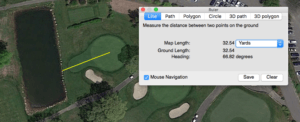
Golfers at any level can lower their scores without making a single change to their swing by having the optimal strategy on the course. One of the best course management tips I would give to any player is knowing key yardages to various targets on every hole they play. This can be accomplished a few ways. The one I would like to explore in this article is how to prepare yourself before your round with a trick using Google Earth.
When you have the information at your disposal and you can make a plan beforehand, it will give you more confidence in your club selection and your target. Any time you can remove doubt before you swing a club is a good thing.
Let's explore how you can do some homework before you hit the course to become a better course strategist.
Google Earth is Awesome
I'm a little embarrassed to admit it, but I didn't actually use Google Earth at all before someone showed me this trick. As a former Google employee I should have known, but hopefully most of you reading this will learn something new here!
You can now download Google Earth Pro here, which allows you to measure distances using satellite images.
Once you have the software installed, you can search for your golf course and start zooming in on key holes. From the tools menu, select the ruler function and you can draw lines from various distances on the course (you can select yards or meters).
You could get extremely detailed with this information and make yourself a complete yardage book if you wanted, but for the purposes of this article I'll try to keep it a little more basic.
There are a number of GPS devices and smartphone apps you could use on the course to do this, but I can tell you that it's better to be prepared with this information beforehand because during the round you don't want to waste a ton of time. More importantly, I believe you should have your strategy mostly decided ahead of time rather than making last-second decisions. Of all the course management tips out there, this is one of the most important ones in my opinion.
Hazards and Trouble
Knowing your exact yardages on key shots to water hazards, bunkers, and out of bounds stakes is important information to know. I'll show you a few examples from my golf course to give you ideas.
Clearing a water hazard

This is the 18th hole at my golf course. It's a reachable par 5 for me, and I'm always faced with the decision on whether or not I can clear the water hazard easily. That decision becomes a lot easier when I know that it's just over 30 yards to clear the hazard from the distance to the center of the green. If I am almost certain I clan clear the hazard then I'm always going to elect to go for it rather than take a guess.
Key bunker placements
Landing in fairway bunkers is one of the most penal shots in golf, and any stats expert would tell you that avoiding them will save you strokes over time. Here are two examples of important fairway bunkers at my course.

This is a par 5 where a fairway bunker is placed in a key spot if you plan on laying up to a wedge distance. Looking at Google Earth I can see that the bunker starts 55 yards from the center of the green, and is about 20 yards long. If I'm laying up I know I want to either place myself safely before the bunker, or have plenty of distance to clear it. Leaving myself an awkward bunker shot from 50 yards is the last thing I want to do!

Here is a challenging tee shot on the first hole. There is out of bounds on the left and a fairway bunker on the right. I have to hit the ball roughly 250 yards to reach the bunker which for me means a 3-wood or driver would bring that into play.
Fairways
One thing you want to look out for is where a fairway gets "squeezed." Typically a golf course architect will tempt players to go for it in areas that become extremely narrow. You can easily check fairway widths with Google Earth, especially when there are hazards around.
Here is an example of a short par 4. I've done a few measurements here based on these two lines.

The line on the right represents the safer play. The fairway is much wider (26 yards), and is 135 yards away from the green where I marked it. I also measured that it's roughly a 200 yard tee shot to this spot.
The line on the left represents trouble. I can get more aggressive and leave myself only 110 yards into the green, but as you can see there is a bunker and the fairway narrows to about 15 yards in width. In my opinion it's not worth bringing the bunker into play, or the narrow portion of the fairway. I can hit a 200-210 yard tee shot and still leave myself a short iron into the green without risking much.
Course Management Tips - Make Your Decisions Beforehand
One of the best course management tips I would give any golfer is to process your information before your round, and go in with a plan. You can take a look at a lot of these yardages and make decisions on what clubs you will play off the tee, and know some important distances to trouble and hazards around the course.
I believe this is a great exercise because it will allow you to do some thinking and analyzing before your round begins. You don't want to figure things out on the course because it wastes mental energy and results in indecision.
Additionally, I recommend that most golfers use GPS devices (here is my favorite one) that will give you yardages to the front, center, and back of the green.
If you want to get more course management tips, you can join our newsletter, and I will send you a copy of our free eBook on golf strategy here.
We care about the protection of your data Read our Privacy Policy